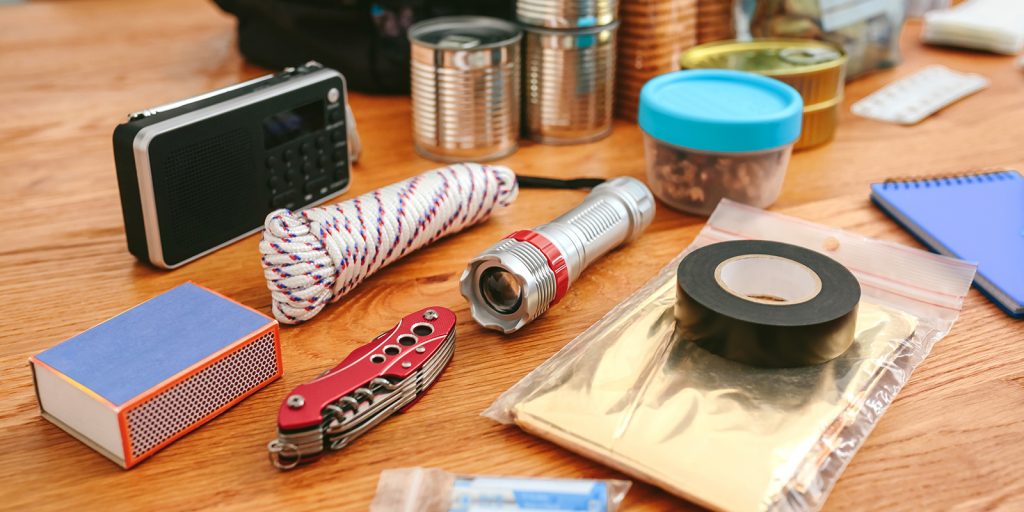You can listen to a short version of the article. If it’s more convenient for you, turn on the podcast.
Why do you need an emergency suitcase?
This basic kit things help to hold out in an extreme situation until rescuers arrive or evacuate from the danger zone. As a rule, it includes a minimum set of clothing, hygiene items, medicines, tools, self-defense equipment and food. An emergency suitcase assembled according to all the rules allows you to hold out for some time in the absence of water, food, heat and a roof over your head.
In the Ministry of Emergency Situations of Russia recommend keep a ready-made set of essentials, first of all, for those who live:
- in an area of possible earthquakes, tsunamis, recurring serious floods and forest fires;
- near enterprises that work with hazardous substances;
- in areas where there is a high probability of armed conflicts.
To understand whether you need an alarm case or not, experts recommend objectively assessing the likelihood of a natural or man-made disaster in your region. For example, residents of megacities in areas with low seismic activity will most likely not need a full set of things, and can limit themselves to a lighter and more compact version.
What things to pack for an emergency suitcase
An exhaustive list is compiled individually and depends on various factors. Among them is the time during which rescuers can reach the emergency zone; remoteness of the place of residence from large populated areas; personal needs of a person and his family members.
Ministry of Emergency Situations offers focus on this basic set:
- Flashlight.
- Mini radio with the ability to receive VHF or FM bands.
- Spare batteries.
- Utility knife with a set of tools.
- Matches or a lighter.
- Food per day – any high-calorie foods that take up little space, weigh little and are stored for a long time, for example, energy bars, stew, soup bags.
- Bank cards and cash.
- Copies of important documents – passport, driver’s license, birth certificate, documents confirming ownership of real estate and car, and other important papers. It is better to place them in waterproof packaging and place them so that they are easy to take out. You can also add photographs of family and friends to your documents.
- First aid kit – cotton wool, bandages, plasters, BF glue (replaces iodine and brilliant green), activated carbon, antipyretic, pain relievers, medications for allergies, diarrhea and intestinal infections, antibiotic powders, medications prescribed by a doctor that need to be taken regularly.
In addition to the universal set, also can Other things that might come in handy:
- The water supply is at least 0.5 liters per day.
- Duplicates of house and car keys.
- Area map, waterproof compass and watch.
- Inexpensive mobile phone with charger.
- Tourist hatchet.
- Whistle or other signaling device.
- Garbage bags with a capacity of 120 l – 5–6 pcs. They can be cut and built into an awning.
- Wide tape.
- Threads with needles.
- Comfortable shoes and clothing – two sets of underwear, two pairs of socks, spare pants, a shirt or jacket, a raincoat, a hat, mittens, a scarf.
- Mini tent, sleeping bag and thermal blanket.
- Hygiene products – toothbrush with toothpastesoap, towel, toilet paper, paper and handkerchiefs, wet wipespads and tampons, razor, manicure set.
- Dishes – a cauldron, spoons and forks, a metal mug, a folding cup.
- Vodka or medical alcohol.
All items in the emergency suitcase must be new. It is better not to use them in everyday life, and also periodically check and update them if the expiration date of products and medicines is coming to an end.
Where to put everything
The best choice is backpack. If you have to walk, it will be easier and more convenient to carry than a bag. The backpack must be of high quality and durable so that it does not fall apart after 30 minutes of wear in extreme conditions. It would be good if it had a lower section – a “basement” or valve, as well as a rain cape. If you don’t have it, you can buy protection separately.
Small and expedition backpacks should not be stacked according to the “heavy at the bottom, light at the top” principle, but so that the weight in them is distributed evenly. To protect the contents from moisture, plastic bags with a clip are useful. Small items and essentials like a first aid kit and flashlight can be stored in the pockets, while food and a change of clothes can be stored in the bottom of the main compartment. In general, you should put everything in your emergency suitcase so that you can quickly and easily find what you need.
Read also ❗❗❗
